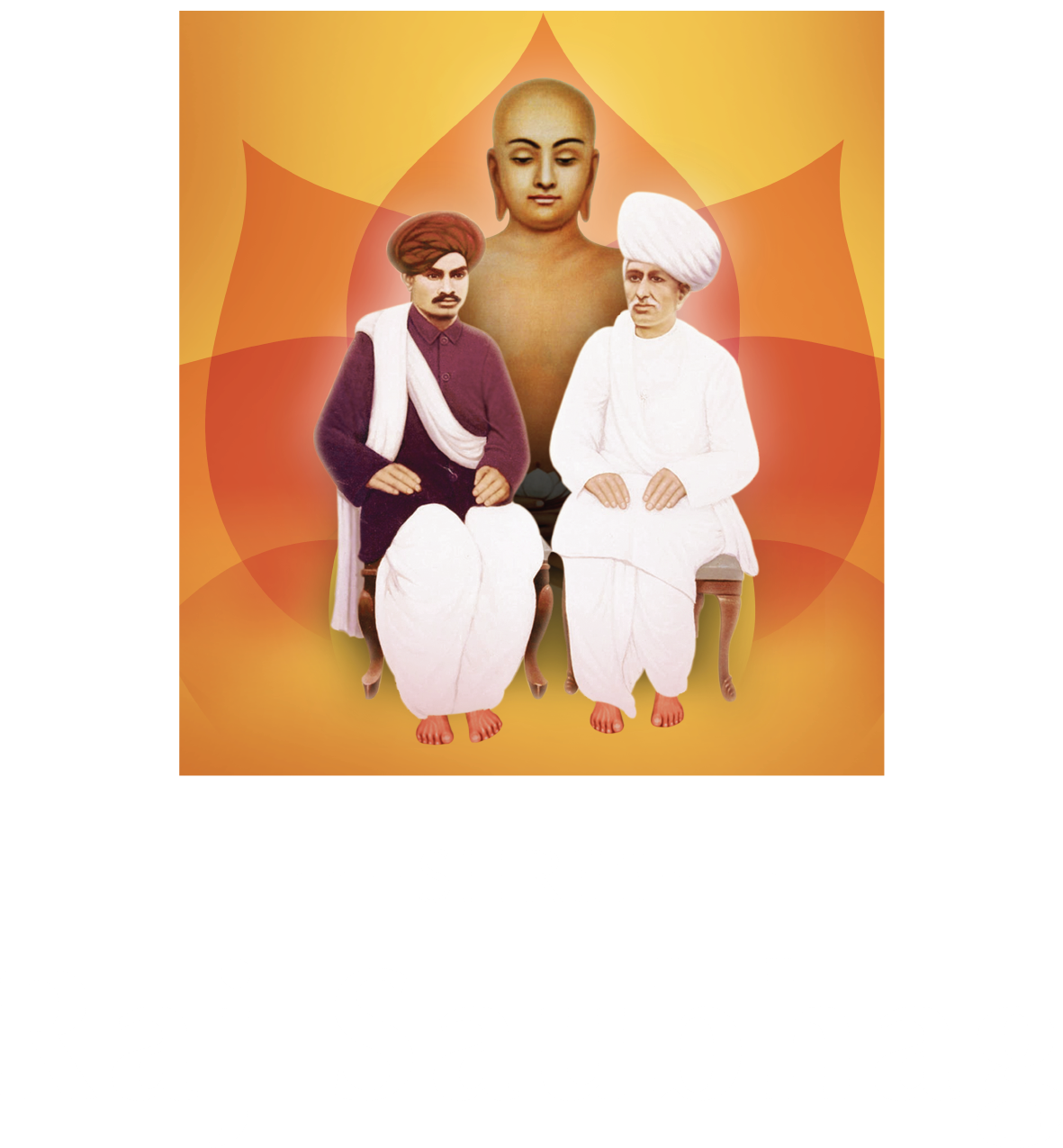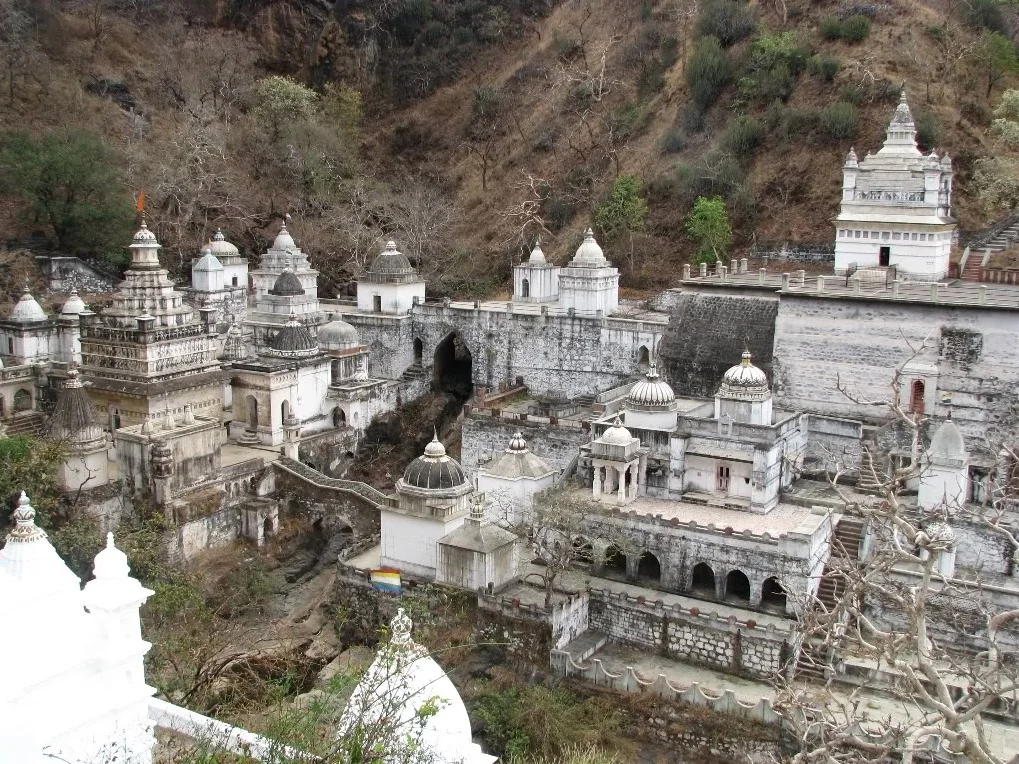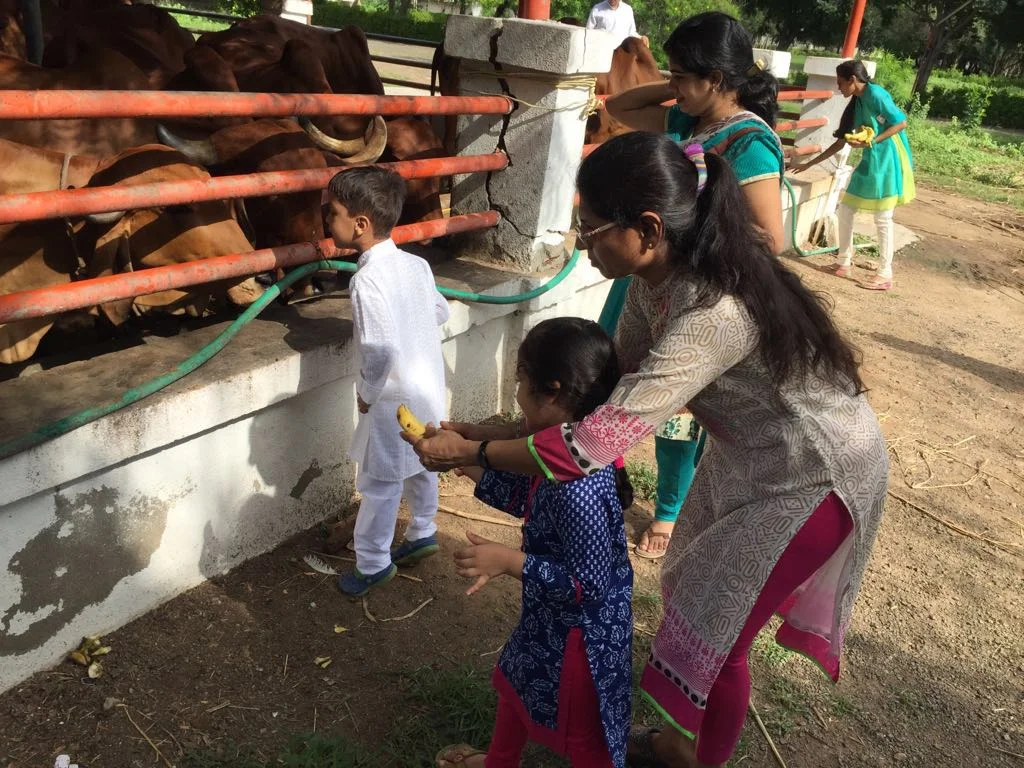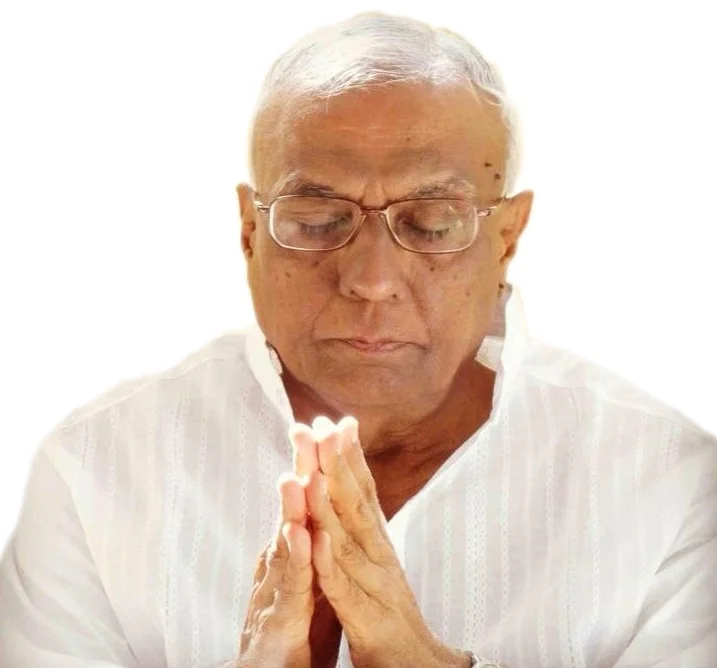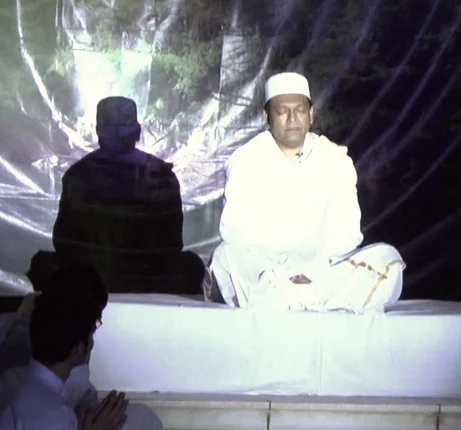Mahapujan of Shrimad's Poems
Shree Bhaktamar Stotra Mahapujan
Shree Bhaktamar Stotra Mahapujan
28th October 2016
The ashram was resplendent as ever, its magical aura enhanced by the tasteful decoration of lights and diyas all round for Diwali. On Dhanteras, a Mahapoojan (ceremonial veneration) of the holy Shree Bhaktamar Stotra was held at the new swadhyay hall. Two mumukshus, Rupaben and Himanshubhai Jain, sponsored it in the memory of Himanshubhai’s father, Late Shri Madhukantbhai Jain.
The arrangements were meticulous – each family had a dedicated ornate stool and a Bhaktamar Yantra to themselves, along with a bowl of vaskep (powder made of sandalwood, saffron and camphor). At the end of the recital of each gatha (verse of four lines) of Shree Bhaktamar Stotra, one was to sprinkle vaskep on a square on the Yantra as a symbol of offering and devotion. Three types of pujan – coconut, fruit and lamp - were offered by three persons for each gatha.
Thanks to the splendid arrangements, each one of us could participate fully in this empowering ceremony. The vidhikaar Panditji Hiteshbha, who had arrived from Baroda especially for the Mahapujan, conducted it with a great deal of precision. He explained the meaning and significance of every word before reciting the gatha, and enjoined us to say “Swaha” aloud each time as ‘swaha’ implies an earnest offering from our heart.
After every four verses (gathas), Brahmanisht Vikrambhai and Yashika would render a stirng bhakti song in the praise of our rthankars. We were asked to chant “Om Hrim Shree Adinathay Namah” in our minds throughout.
Shree Bhaktamara Stotra is composed by Acharya Mantung Maharaj Saheb. It is said that when he was shackled by the king, he composed the Stotra, and as he recited every verse of the Stotra, each chain broke open. When an unconvinced king tested the power of the Stotra by imprisoning another devotee of the Stotra, Hemraj Sheth, the power of the Stotra was proved by Sheth in the same manner.
Bhaktamar literally means that which makes the disciple immortal. These verses describe the fine qualities of Jineshwar Bhagwan. When recited with commitment, sincerity and devotion, this magnificent composition has the latent power to lighten our karmic load and connect us with the Jineshwar Bhagwan or the divinity within.
Verses 1 to 9 depict the poet’s humility in his endeavour to describe the grandeur of Jineshwar Bhagwan – a task that can be accomplished not through the use of one’s intelligence or ability but by sheer devotion.
Verses 10 to 33 sing the glory of Jineshwar Bhagwan, whose one darshan changes you so much that you cannot ever be satisfied with anything worldly again. No sansaric thought or flaw ever remotely comes near Him, centred as He remains in His state of bliss. Anyone who worships this transcendental state of being with all his heart is released from the ills of worldly life and achieves identical equanimity.
Verses 34 to 44 relate to the spiritual and worldly benefits of Paramatma bhakti. Reciting Verse 41, for instance, has the potential to cure an ailing person, or give him peace. The Panditiji mentioned that using the water used for abhishek of the Bhaktamar Yantra along with the recital of this verse can work wonders for the ill. Verse 43 and 44 tell us how, like beads on a necklace, each verse in the glory of Jineshwar Bhagwan is entwined around His divine attributes.
The dogmatic richness of Shree Bhaktamar Stotra is sufficient to transport you to the world ofthe holy; when coupled with a flawless rendition of each gatha, with attentive participation of each and every mumukshu under the guidance and ever-flowing grace of P.P. Bhaishree, it acquired a life all its own. The gathas reverberated in the atmosphere, touched each one of us vibrantly and left each one of us aglow with an inner radiance we did not know we had.
We felt cleansed and ready to soak in the spiritual fest that awaited us.
Diwali 2016
Diwali Celebrations
30th October 2016
Diwali is a important day in the Jain calendar – the day Bhagwan Mahavir attained Nirvana (freedom from the cycle of births and deaths). It is the day we re-align ourselves with the ultimate goal for this lifetime – self-realisation, which is a stepping stone to nirvana. Diwali is an opportunity to calibrate our thoughts, actions and deeds to see if we are on course and correct ourselves if we are not.
It is therefore crucial for us on this day to be with the one person who is showing us the way and leading by example. Thus, we descended in droves on Sayla ashram, our oasis of divine love. Spending the four days of the festival, from October 28-31, 2016, with Param Pujya Bhaishree in Sayla was like dancing in a blissful spiritual shower, with kindred angels smiling down on us.
On Diwali day, Bhagwan Mahavir gave his last deshna (sermon). The Samovarasan (the assembly of all manner of living beings including celestial beings who gather in peace and amity to listen to the sermon of a Tirthankar) was blessed to receive this divine knowledge. At the stroke of midnight, He attained nirvana. His emotionally overcome disciple, Gautam Swamy, could not bear the thought of separation from his Guru, attached as he was to His physical form. A highly evolved soul himself having ascended right up to the second-last stage of spiritual enlightenment, he soon freed himself from this sentimental bondage and attained Keval gyan (complete knowledge). That was at 5 am on New Year’s Day.
At Sayla, we celebrated Diwali with three rounds of 108 chants each of the three mantras recited at these three times:
Om Hrim Shree Mahavir Swamy Sarvagney Namah
Om Hrim Shree Mahavir Swamy Paargataay Namah
Om Hrim Shri Gautam Swamy Sarvagney Namah
The chanting was initiated by Br. Minalben. The hall resonated with an other-worldly vigour, as hundreds of voices, steeped in bhakti, joined the chanting. A rarefied energy field was created in and around the Kalyan Hall, with Param Pujya Bhaishree as its centrifugal force. It was an indescribable moment that could only be felt, barely expressed.
The special Diwali swadhyays (discourses) spread over four days were aimed at getting our wandering thoughts back on the spiritual track with Bhagwan Mahavir’s visualisation of a future that will, to our regret and horror, see the abandonment of the path by most Jains.
Param Pujya Bhaishree’s swadhyays on the significance of Diwali were based on the book, ‘Sor prahar diye deshna’, by Acharya Vijay Mahabodhsuriji Maharaj. At the outset, Bhaishree reminded us of the importance of celebrating festivals within rather than without. External festivities lead to karma bandh (accumulation of karma); internal festivities lead to aatmakalyan and liberation. Tools such as tap (penance), tyaag (renunciation), jap (chants), dhyaan (meditation) help us in achieving this inner evolution through the process of karma nirjara (shedding of karma).
King Samprati and Acharya Suhastisuriji Maharaj
The book is a detailed narration of Acharya Suhastisuriji Maharaj’s explanation of the Diwali festival to his disciple, King Samprati, grandson of Emperor Ashok of the Maurya dynasty. The incident dates about 2200 years ago and about 200 years after Bhagwan Mahavir’s time on earth. Inspired by his guru to propagate Jainism, King Samprati is known for building 1.25 lakh Jinalays, among other things. On his query about the relevance of Diwali, Acharya Suhastisuriji Maharaj expounded Bhagwan Mahavir’s prophesies of a grim and bleak future in the Fifth Aara (a Jain division of time characterized by pain and sorrow), also known as Dukham kaal. The Fifth Aara began about 2,500 years ago and will last another 21,000 years.
When King Punyapaal asked Bhagwan Mahavir the meaning of eight dreams that he had had, Bhagwan Mahavir interpreted each dream for him expansively in terms of their relevance today and for the future. Some of the key points in brief:
1. Dream: Good, beautiful elephants in a derelict house that only a few wanted to get out of. Meaning: The house depicts our worldly trappings that we do not wish to leave. In the Fifth Aara, man’s looks and health will diminish; he will live a life of deceit and be in perpetual fear.
2. Dream: A group of monkeys plastering faeces on their bodies, because they believe it to be sandalwood. Meaning: A similar deception will play in the minds of Jain monks in the Fifth Aara, sucking them into a vortex of sin. They will be hyperactive, restless, resist any pointers that they are straying from the path and drag their followers into it.
3. Dream: A barbed wire fence around a milk-oozing tree, some lion cubs sitting in the shade, and some dogs clinging to the tree. Meaning: The tree depicts Jain followers, the lion cubs depict Jain monks. Both play their roles very well till the advent of the Fifth Aara which will make them fight among themselves, turn lazy, and lose the ability for self-realisation. The followers will believe they are smarter than the monks; just a few monks will survive the onslaught of the age and keep away, like the barbed wire, from the wrong doers.
4. Dream: Crows perched on an almost parched pond instead of a vast lake nearby; chasing a mirage, they died thirsty. Meaning: the crows depict the Jain preachers and their followers. In the Fifth Aara, the monks will be lax, greedy, indisciplined and yet, will attract more followers than the few good ones. Like the crows, the followers will not be content with one dharmaguru and flit from one group to another.
5. Dream: A dead lion whose decaying body emits an unbearable stench and is being eaten by worms. Meaning: Jainism is the lion in the metaphorical Indian jungle. But in the Fifth Aara, there will be barely a few practising Jains. Like the worms, Jain monks and followers will ridicule Bhagwan Mahavir’s teachings and get drawn to flawed practitioners of religion. Special powers, or labdhis, will vanish.
6. Dream: Unattractive lotuses without any fragrance amid rotting garbage. Meaning: A lotus spreads its fragrance and beauty all round the way true Jains would spread the fragrance of good conduct and thought. But in the Fifth Aara, pious souls will not be born in noble families. They will eat taboo food and call those practising dharma foolish. They will be rude to elders and banish them to old age homes.
7. Dream: Sowing of seeds in infertile land. Meaning: In the Fifth Aara, this symbolizes the loss of the sense of discrimination (vivek) between right and wrong. Jain followers will be conceited and veer towards cultivating the deceptive monks instead of the few true monks. They will spoil them with comforts and luxuries, and distract them from their path.
8. Dream: Gold pots of two types – fragrant, festive ones on a pinnacle of a temple top and filthy, broken ones on the floor. Meaning: Jain monks will have impeccable character till the Fifth Aara when their resolve will slowly break. They will fall down the pinnacle of character and seep in an abyss of indiscipline and self-destruction.
Alarmed at the prospect of a future without religion, King Punyapaal and all others renounced the world, did penance and attained Keval gnan. Bhaishree said that a couple of thousand years later, some of the prophesies already seem to be ringing true in our time. He said we were fortunate to have this path. All we need to do is be determined not to relent till our work is accomplished. A steely resolve can drive a seeker far and fast right up to his goal of samyag darshan.
By the end of the Diwali swadhyays, Bhaishree’s message had gone home: eshew the degenerative fibre of the Fifth Aara like the plague and plunge into the oasis of calm and soothing spirituality right in front of you. If the horrific depravity of the Fifth Aara is to be avoided, there is just one way – and the good news is that we have access to the path as well as to a leader shining a light on it.
The silver lining in each of the eight dreams was the presence of a few good souls in the form of Jain followers or monks who refused to get waylaid by their times and remained true to their path. May we be them.
Diwali Swadhyays
29 - 31th Oct 2016
Sor Praher Diye Deshna explained by Param Pujya Bhaishree
Sor Praher Diye Deshna - part 1
Sor Praher Diye Deshna - part 2
Sor Praher Diye Deshna - part 3
Sor Praher Diye Deshna - part 4
Sor Praher Diye Deshna - part 5
Sor Praher Diye Deshna - part 6
Animal Care - Experiences & Reflections of children
Vavania, Morbi and Rajkot Jatra 2016
Vavania, Morbi and Rajkot Jatra
6th September 2016
The week-long Jain festival of Paryushan aims to cleanse the heart and soul of ill-feelings borne towards any and every living being by seeking and granting forgiveness for hurt caused through thoughts, words or deeds. Cultivating the quality of forgiveness and humility elevates the soul, opening the door to virtues like compassion and kindness.
Every year mumukshus of Shree Raj Saubhag Ashram accompany Param Pujya Bhaishree for a spiritual Jatra to the birthplace of our Aradhya Dev Param Krupalu Dev –Vavania, Morbi and Rajkot. This ritual was followed by Param Pujya Bapuji diligently as a mark of respect to our supreme benefactor Shrimad Rajchandra. This year, on the 6th of September, mumukshus departed for the pilgrimage in the morning hours.
Morbi
The first port of call was Morbi, the place where Shrimadji was married to Jhabakba. Visiting these premises mumukshus could sense the pure vibrations emanating here – the place where Shrimadji was required to enter into matrimonial alliance inspite of being completely detached inwardly. This is the power of karma. Requesting eternal companionship of Shrimad, mumukshus sang soulful bhajans like “જોડે રેહજો રાજ”.
Vavania – the birthplace of Shrimadji
As the entourage arrived at the beautiful Janma Bhuvan and Rambai Mandir - Vavania, they felt a sense of divinity and awe. The grandeur and the serenity filled everyone with a sense of gratitude. Inspirational quotes of Shrimadji were engraved at the entrance and entry doors of the entire Bhuvan.
After lunch, mumukshus assembled at the Swadhyay hall. Each mumukshu was absorbed in his own sadhna – either doing meditation, or reading the quotes all over the place or in deep contemplation and introspection.
As Pujya Bhaishree arrived, he first bowed his head in reverence to the idols of the Tirthankara, Chandraprabhu Swami, Rushabdev Swami and Mahavir Swami Bhagwan.
On the right side of the Mandir was the Guru Mandir, in which the idol of Param Krupalu Dev was placed. Mumukshus sang devotional songs like “Amee bharela ae nayan, Het bhinu ae vadan, Yaad aave aaj”, and chants of “Dev Krupalu, Dev Krupalu, Dev…” filled the air and their hearts, reverberating through the halls, enhancing the divinity of the place.
One mumukshu said: “A thought that came to my mind was that such a great Yug Purush was born is such a remote place, but this shows that even great elevated souls and saints have to bear the fruits of their own karma.”
Rajkot
The last destination of the tour was Rajkot. This city to all the followers of Shrimadji denotes an element of sadness. This is the place where Shrimadji breathed his last as he continued on his great onward journey to salvation, Moksh.
Mumukshus visited the Samadhi Mandir, the place where Shrimadji was cremated. Even the Father of the nation Mahatma Gandhi paid rich tributes to his spiritual master, his Guru – Shrimadji here.
Here also after a short Bhakti session, the tour proceeded to Narmada Mansion, the place where Shrimadji spend the last few months of his great life as he recuperated from his illness. Shrimadji had even written an extremely memorable and inspiring spiritual poem here and it was in Narmada Mansion, that this divine soul breathed his last.
As the pilgrimage drew to an end, mumukshus departed while making a resolve to follow Shrimadji’s teachings more diligently.
